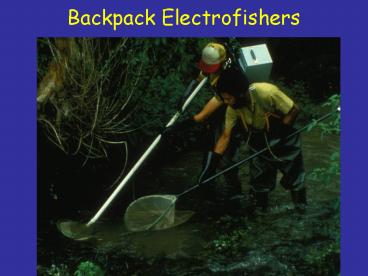Backpack Electrofishers - PowerPoint PPT Presentation
1 / 37
Title:
Backpack Electrofishers
Description:
... gasoline versus extra batteries; also, can deliver AC (often most effective in ... engines in U.S. now not legal to manufacture (need to go to 4-stroke engine) ... – PowerPoint PPT presentation
Number of Views:319
Avg rating:3.0/5.0
Title: Backpack Electrofishers
1
Backpack Electrofishers
2
Backpack Electrofishers
12 V battery
Metal frame backpack
3
Backpack Electrofishers
Center of gravity is high
Non-conductive frame
Sealed battery
4
Some Recent Backpack Models
ETS ABP-3
Smith-Root LR-24
Hans-Grassl
5
Safety Features(other than circuit breakers,
thermal sensors, fusible links)
Smith-Root LR-24
Emergency shutdown switch
Internal tilt switch (forward 55-, side 45-,
backward 35-degrees)
Quick-release harness
Audio alarm 1-4 beeps/sec depending upon average
power output
Internal anode out-of-water switch
Flashing red light
Lower right of frame
Splash cover must be latched
Anode switch
Immersion sensor
6
Backpack Controls
Table on back of pulsator that
provides alpha-numeric code for selection of
waveform type (DC, PDC, Gated Burst), frequency,
and pulse width Letter frequency Number
pulse width
7
Backpack Controls
Mode switches set a H, 3 ( 50 Hz, 2 ms pulse
width)
Voltage at 100 V steps (coarse)
8
Backpack Controls- better
Peak reading metering
I increments
5 V increments
1 Hz increments
9
Generator-Powered Backpacks
Houston, we have a launch
10
Generator-Powered Backpacks (better)
Power capacity 350 W average
11
Battery- or Generator-Powered?
- In the U.S., generator and battery backpacks can
have similar average power output (350 W vs. 400
W) - Battery-powered quiet
- Generator-powered in high conductivities, due to
the amperage draw, may be easier to carry-in
additional gasoline versus extra batteries also,
can deliver AC (often most effective in extreme
conductivities) - Larger capacity 2-cycle engines in U.S. now not
legal to manufacture (need to go to 4-stroke
engine)
12
Electrodes
Anode diamond
Cathode cake-pan
13
Electrodes- Anodes
14
Electrodes- Cathodes
Rattail, note long length runs along bottom
Beavertail, floats
15
Dual-channel Application
ETS ABP-2 (also LR-24) Channel 1 1 10
pps Channel 2 10 1,000 pps
16
Sea Lamprey Larvae Sampling
Power off
Low frequency
17
Backpack Protocols
Note 2 hand-held electrodes Note no gloves
Area sampling along transects
A pass or random walk
Two hand-held electrodes is a common
configuration when using AC
18
Backpack Protocols
Electrofishing removal of an exotic
species, Green sunfish, in Arizona
Portability allows access to many hard-to-reach
places
19
Shore-based Electrofishing
Multiple anodes
Best to make a good ground connection with the
cathode or use a large plate
Safety note nobody on generator
20
Tow Barge Electrofishing
If you need more power or sampling over a long
distance, then go with a tow barge system
21
Tow Barge Electrofishing
Junction box for anodes and safety circuits
Cathode plate on bottom
22
Tow Barge Electrofishing
23
Tow Barge Electrofishing
24
Cataraft (Tow Barge)
25
Cataraft Dorsal view
26
CataraftVentral view
Dropper cathodes
27
Moveable Anodes
Potential hazard!
Anode
Cathode
28
Moveable Anodes
Using DC to capture trout by taxis
Cathode isolated on bottom of hull
Note shape of anode
29
Electric Seine
Used in conjunction with block nets in streams
originally AC used
Dropper electrodes along cable
Each braille (pole) is an electrode
30
Parallel Wires
Power cable
2 parallel wires between brailles
A long, narrow quadrat moved sequentially upstream
31
Pre-positioned Area Shockers (1)
Power on
32
Pre-positioned Area Shockers (2)
Pulling up the seine
Kicking through the quadrat
Examining the catch
33
Diver Operated Anode (DOA)
Old Smith-Root, Inc. backpack shocker
34
Accessory Equipment
Multimeter for trouble-shooting
Measure environmental conditions
Voltage-gradient probe/meter for field mapping
35
Equipment Checks(Page 11-14)
- Calibration of meters or dials
- voltage (peak, average, RMS)
- current (peak, average, RMS)
- duty cycle, pulse width, pulse frequency
- other waveform characteristics (spikes, ripple,
negative excursions) - Multimeters (especially volt-ohm)
- read AC and DC might give avg. PDC
36
Equipment Checks(Page 11-16)
- Trouble-shoot wiring (couplers, electrodes,
pulsator) - Example possible circuit break in the hand-held
electrode - switch
- main circuit
- anode surface
Set multimeter to resistance
37
Equipment Checks(Page 11-17)
- Do not recommend getting into the pulsators due
to shock potential from the capacitors unless
directed by manufacturer - e.g., ETS units have replaceable circuit boards































